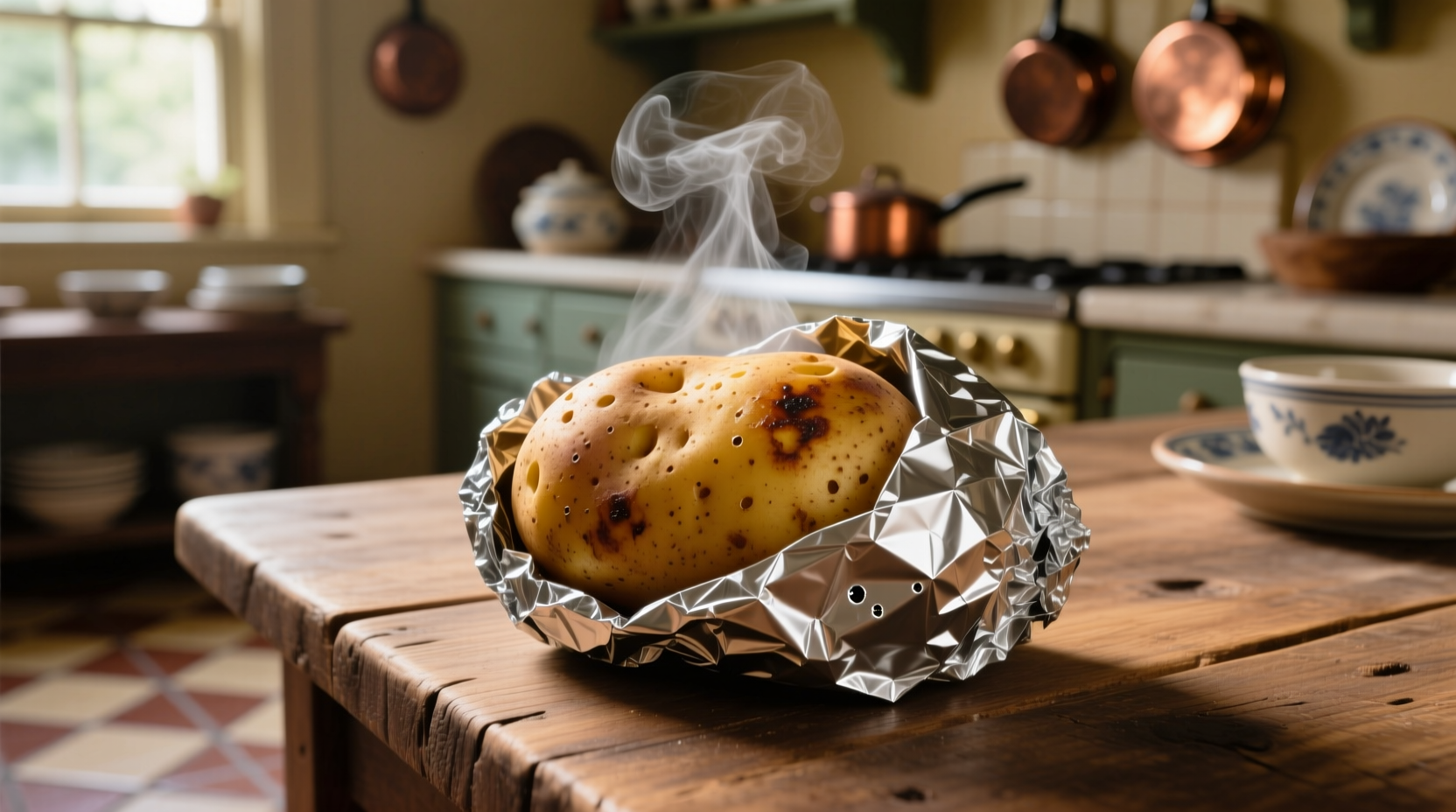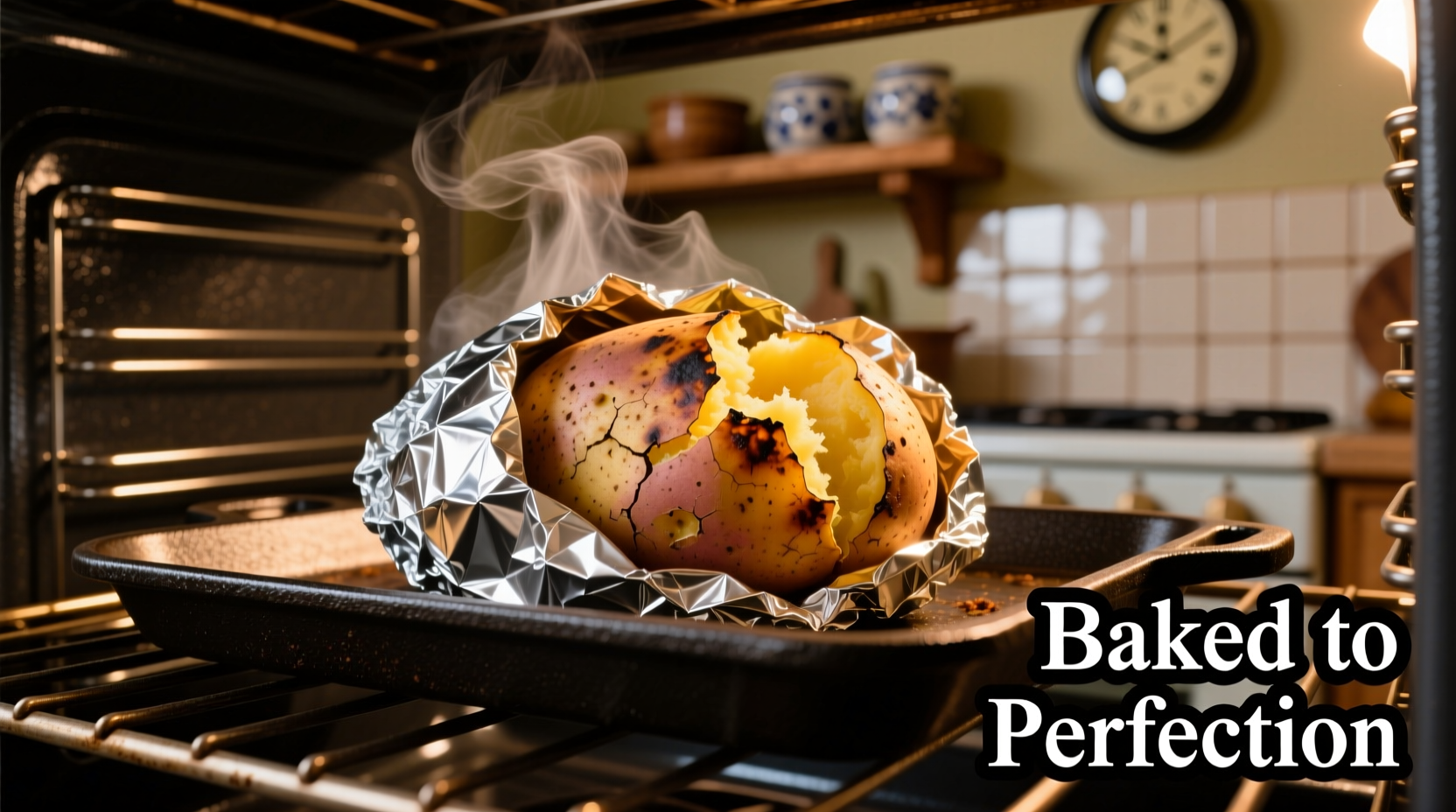The Science Behind Foil-Wrapped Baked Potatoes
When you wrap a potato in aluminum foil before baking, you're creating a mini steam oven. The foil traps moisture released from the potato as it heats, creating a humid environment that cooks the potato through steaming rather than dry heat alone. This process has distinct advantages and limitations compared to traditional baking methods.
| Method | Cooking Time | Texture Result | Best For |
|---|---|---|---|
| Foil-wrapped | 55-65 minutes | Soft skin, very fluffy interior | Quick meals, restaurants, when skin texture isn't priority |
| Unwrapped | 60-75 minutes | Crispy skin, slightly denser interior | Home cooking, texture enthusiasts, flavor development |
Step-by-Step Guide to Perfect Foil-Wrapped Baked Potatoes
Preparation Phase: Setting Up for Success
Select medium-sized russet potatoes (8-10 ounces) for most consistent results. Larger potatoes require significantly longer cooking times that often lead to uneven results. Thoroughly scrub potatoes under cold water to remove dirt, then dry completely with a clean towel.
Using a fork, poke 8-12 holes around each potato, penetrating about ¼ inch deep. This critical step allows steam to escape during baking, preventing potential explosions in your oven. According to the USDA Food Safety and Inspection Service, proper venting is essential when baking any starchy vegetable that contains moisture [source: USDA FSIS Potatoes Guidelines].

Wrapping Technique: Getting the Foil Right
Use heavy-duty aluminum foil for best results. Tear off a sheet approximately 18 inches long. Place the potato in the center, then bring the foil edges together above the potato. Crimp the top edges tightly to create a sealed packet, leaving about ½ inch of space around the potato. Don't wrap too tightly—potatoes need room to expand during cooking.
For enhanced flavor, add a few drops of olive oil and a pinch of salt directly on the potato before wrapping. This creates a subtle seasoning effect as the potato steams in its own moisture.
Baking Process: Temperature and Timing
Preheat your oven to 400°F (200°C)—this temperature provides the optimal balance between cooking speed and texture development. Place foil-wrapped potatoes directly on the center oven rack, not on a baking sheet, to ensure even heat circulation.
Set a timer for 55 minutes for medium potatoes (8-10 ounces). Larger potatoes (12+ ounces) may require 65-75 minutes. The exact time depends on your oven's calibration and the potato's density. Don't open the oven during the first 45 minutes to maintain consistent temperature.
Determining Doneness: The Critical Check
After 55 minutes, carefully remove a potato using oven mitts. Gently squeeze the packet—if the potato gives easily to pressure, it's done. For precise testing, insert an instant-read thermometer into the thickest part of the potato through the foil. The internal temperature should reach 205-210°F (96-99°C) for perfect doneness.
Let potatoes rest in their foil packets for 5-10 minutes after baking. This resting period allows the starches to set properly, preventing a mushy texture when you open them.
Common Mistakes That Ruin Foil-Wrapped Baked Potatoes
- Skipping the poking step—leads to potential bursting and uneven cooking
- Using thin foil—causes tears that release steam and extend cooking time
- Overcrowding the oven—blocks heat circulation and creates cold spots
- Not preheating properly—results in longer cooking times and uneven texture
- Opening the foil too soon—releases valuable steam that keeps the potato moist
When Foil Wrapping Makes Sense (And When It Doesn't)
Foil-wrapped baking shines in specific scenarios but falls short in others. Understanding these context boundaries helps you choose the right method for your needs:
- Choose foil wrapping when: You're short on time, cooking multiple potatoes simultaneously, or want consistently soft skin (common in restaurant settings)
- Avoid foil wrapping when: You want crispy skin, are using heirloom potato varieties, or prioritizing maximum flavor development through caramelization
Food science research from America's Test Kitchen demonstrates that unwrapped potatoes develop more complex flavor compounds through the Maillard reaction on the skin surface [source: America's Test Kitchen Baking Guide]. However, foil-wrapped potatoes reach serving temperature faster, making them practical for weeknight meals.
Better Alternatives to Aluminum Foil
If you're concerned about environmental impact or potential aluminum migration (though minimal at baking temperatures), consider these alternatives:
- Parchment paper packets: Creates slightly less steam than foil but still protects the potato
- Silicone baking mats: Reusable option that allows some moisture escape for better texture
- Direct baking with oil rub: Skip wrapping entirely and rub potatoes with oil for crispy skin
For those seeking the moisture benefits of foil without the environmental concerns, Cornell University's Food Science department recommends using reusable silicone baking pouches as a sustainable alternative that maintains similar cooking properties [source: Cornell Food Science Resources].
Serving Suggestions for Maximum Enjoyment
When opening foil-wrapped potatoes, carefully tear open the top to release steam away from your face. For the fluffiest texture, use a fork to lift the top layer of potato straight up before adding toppings.
Classic topping combinations include:
- Sour cream, chives, and bacon bits
- Melted butter, salt, and freshly cracked pepper
- Cheddar cheese and jalapeños
- Broccoli and cheese sauce
For enhanced flavor integration, mix your toppings directly into the potato rather than just placing them on top. This technique creates more balanced bites throughout the potato.











 浙公网安备
33010002000092号
浙公网安备
33010002000092号 浙B2-20120091-4
浙B2-20120091-4